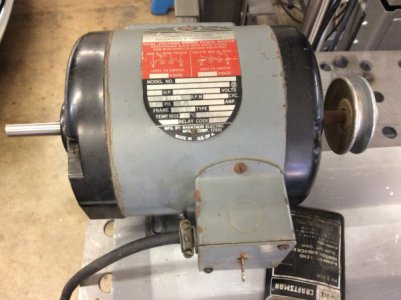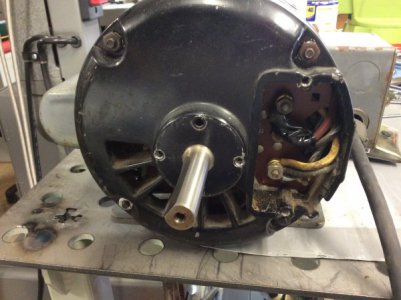Happy Labor Day,
I am working on this 1947 Delta 14” band saw.
I am getting close, just need one more bearing and I thought I was ready to go.
I replaced the electrical source 14/3 wire. Plugged it in and the GFI tripped immediately.
I checked my work, all looked good.
I removed the end shield and cleaned the points. They were pretty bad. I also discovered a chaffed wire. One of 3, there are two sets of 3 wires. See pic.
I taped the damaged insulation assuming that was it. Blew all the saw dust out of the motor etc.
I plugged it and it ran perfect, for about ten seconds, then tripped the GFI.
I haven’t checked amp load yet.
This is a 115/230 ac motor. 1/2 HP, frame is 56. Rated at 7.7 amps at 115 v which is how it is wired now.
Please excuse the improper names I applied to the components, I really am an idiot when working on anything electrical.
I would like to save this motor. I’ll look for more shorts in the mean time.
Do you think it can be saved?


I am working on this 1947 Delta 14” band saw.
I am getting close, just need one more bearing and I thought I was ready to go.
I replaced the electrical source 14/3 wire. Plugged it in and the GFI tripped immediately.
I checked my work, all looked good.
I removed the end shield and cleaned the points. They were pretty bad. I also discovered a chaffed wire. One of 3, there are two sets of 3 wires. See pic.
I taped the damaged insulation assuming that was it. Blew all the saw dust out of the motor etc.
I plugged it and it ran perfect, for about ten seconds, then tripped the GFI.
I haven’t checked amp load yet.
This is a 115/230 ac motor. 1/2 HP, frame is 56. Rated at 7.7 amps at 115 v which is how it is wired now.
Please excuse the improper names I applied to the components, I really am an idiot when working on anything electrical.
I would like to save this motor. I’ll look for more shorts in the mean time.
Do you think it can be saved?


